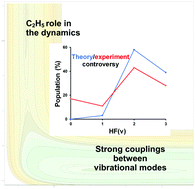Role of an ethyl radical and the problem of HF(v) bimodal vibrational distribution in the F(2P) + C2H6 → HF(v) + C2H5 reaction
Abstract
A theoretical study of the dynamics of the F(2P) + C2H6 hydrogen abstraction reaction was presented using quasi-classical trajectories propagated on an ab initio fitted global potential energy surface, PES-2018. The results were compared with experimental information at a collision energy of 3.2 kcal mol−1. We found a small fraction of available energy, 13%, deposited as C2H5 internal energy, the largest fraction, 67%, being deposited as HF(v) vibration, where the HF(v,j) rotational distribution is colder when the vibrational level increases. These results reproduce the experimental evidence. In addition, the reaction cross section scarcely changes with energy, and the scattering distribution shifts from isotropic to forward when the HF(v) vibrational state increases. These last two findings await experimental confirmation. Finally, two important issues related to the title reaction were analysed: the role of an ethyl radical, and the theory/experiment controversy about the HF(v) bimodal vibrational distribution. We found that in spite of its low internal energy, the ethyl product does not act as a spectator of the reaction, and that the controversy can be explained by the net result of two opposite effects: strong couplings between vibrational modes, which are the rule and complicate dynamics analysis in polyatomic systems, and an artificial energy transfer from the ethyl radical to the HF molecule due to the classical nature of the quasi-classical trajectory calculations. As is seen, the ethyl radical actively participates in both effects.



 Please wait while we load your content...
Please wait while we load your content...